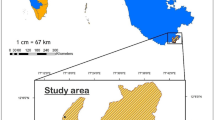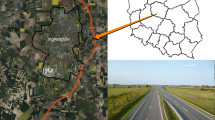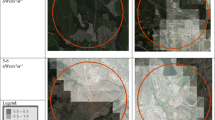Summary
Nest-site selection and breeding success was studied in a breeding population of Roller (Coracias garrulus) in the Southwest of Spain. 567 nest-boxes were installed on electric pylons in seven different habitats: fallow land, cereals, holm oaks, olive groves, pasture land, irrigated crops (rice and maize) and shrubs. The more favoured habitats were the irrigated crops, the olive groves and the holm-oaks, while only the cereals were clearly avoided. Fallow land, pastures and shrublands were preferred approximately according to their availability in the area. The mean laying date of Rollers was significantly different between habitats, however, the other reproductive variables did not vary with habitat type. The seasonal trend in reproductive value of the Roller varied relative to habitat type. So, in olive groves and irrigated crops no clear seasonal trends were detected in clutch size, while a clear seasonal decline in clutch size was detected in the rest of the habitat types. The intensity of selection of each habitat was only marginally related to the hatching success of the rollers in Extremadura. These results indicate that the decrease in natural nest-sites as a result of the intensification of agriculture is the principal cause of the decline in Roller populations in contrast to previous studies which argued that this was a consequence of the decrease in available food.
Zusammenfassung
In einem Gebiet in SW Spanien wurden Nistplatzwahl und Brutbiologie der Blauracke untersucht. Dazu wurden 567 Nistkästen in sieben verschiedenen Lebensräumen an Hochspannungsmasten angebracht, in Brachland, Getreide, Steineichen, Olivenhainen, Weideland, bewässerte Reis- und Maisfelder und in Buschland. Die bevorzugten Habitate waren die bewässerten Flächen, die Olivenhaine und die Steineichen; die Getreideflächen wurden auffällig gemieden. Brachland, Weideflächen und Buschland wurden etwa entsprechend ihres Flächenanteils im Gebiet genutzt. Der mittlere Legebeginn, nicht jedoch die anderen brutbiologischen Parameter, unterschied sich signifikant zwischen den Habiaten. Auch der saisonale Verlauf der Brutdaten variierte zwischen den Lebensräumen. Mit Ausnahme der Olivenhaine und der bewässerten Flächen nahm die Gelegegröße in allen anderen Habitaten mit Fortschritt der Brutzeit ab. Die Habitatwahl war nur wenig vom Bruterfolg bestimmt. Die Ergebnisse zeigen, dass der Verlust natürlicher Nistplätze in Folge der Intensivierung der landwirtschaftlichen Nutzung der haupsächliche Faktor für den Rückgang der Blauracke in der Estremadura ist und nicht, wie früher angenommen, der Rückgang an Nahrung.
Similar content being viewed by others
References
Atienza, J. C. (1994): La utilización de índices en los estudios de selección del recurso. Ardeola 41: 173–176.
Avilés, J. M. (1999): Distribución de la población nidificante de la CarracaCoracias garrulus en España. Ardeola 46: 223–226.
Avilés, J. M. & Costillo, E. (1998): Selection of breeding habitats by the Roller (Coracias garrulus) in farming areas of the Southwest of the Iberian Peninsula. Die Vogelwarte 39: 242–247.
Avilés, J. M. & Parejo, D. (1997): Dieta de los pollos de Carraca (Coracias garrulus) en una zona mediterránea (Extremadura, suroeste de España). Ardeola 44: 237–239.
Avilés, J. M. & Sánchez, A. (1997): Evolución del número de parejas reproductoras de CarracaCoracias garrulus en cinco hábitats de Extremadura. Butll GCA 14: 25–29.
Avilés, J. M., Sánchez, A. & Muñoz, A. (1998): Influencia de la edad del nidal y la presencia de otras especies sobre las fechas de puesta de la Carraca (Coracias garrulus, L) en estepas de Extremadura (SO península ibérica). Misc, Zool. 21: 1–7.
Avilés, J. M., Sánchez, J. M., Sánchez, A. & Parejo, D. (1999): Breeding biology of the RollerCoracias garrulus in farming areas of the Southwest of the Iberian Peninsula. Bird Study 46: 217–223.
Clutton-Brock, T. H. (1988): Reproductive success. Chicago.
Cramp, S. & Simmons, K.E.L. (1988): The birds of the Western Palearctic. Vol V. Oxford.
González-Solis, J., Bernadí, X. & Ruiz, X. (1996): Seasonal variation of waterbird prey in the Ebro delta Rice fields. Colonial Waterbirds 19: 135–142.
Hagemeijer, W. J. M. & Blair, M. J. (1997): The EBCC Atlas of European Breeding Birds. Their distribution and abundance. London.
Jacobs, J. (1974): Quantitative measurement of food selection: a modification of the foage ratio and Ivlev¤s electivity index. Oecologia 14: 413–417.
Järvinen A. (1980): Population dynamics in the Pied FlycatcherFicedula hypoleuca at subartic Kilpisjärvi, Finnish Lapland. Orn. Fenn. 57: 17–25.
Purroy, F. J. (1997): Atlas de las aves de España (1975–1995). Barcelona.
Rivas-Martínez, S. (1981): Memoria del mapa de series de vegetación de España. Ministerio de Agricultura Pesca y Alimentación. ICONA. Madrid.
Sánchez, A. & Sánchez, J. M. (1991): Resultados de la ocupación de cajas anidaderas en tendidos eléctricos en Extremadura (Oeste de España): 1986–1990. Ecología 5: 375–381
Sosnowski, J. & S. Chmielewski. (1996): Breeding biology of the RollerCoracias garrulus in Puszcza Forest (Central Poland). Acta Ornithologica 31: 119–131.
Tucker, G. M. & Heath, H. F. (1994): Birds in Europe: their conservation status. Cambridge.
Zar, J. H. (1996): Biostatistical Analysis. New Jersey.
Author information
Authors and Affiliations
Rights and permissions
About this article
Cite this article
Avilés, J.M., Sánchez, J.M. & Parejo, D. Nest-site selection and breeding success in the Roller (Coracias garrulus) in the Southwest of the Iberian peninsula. J Ornithol 141, 345–350 (2000). https://doi.org/10.1007/BF02462244
Accepted:
Published:
Issue Date:
DOI: https://doi.org/10.1007/BF02462244




